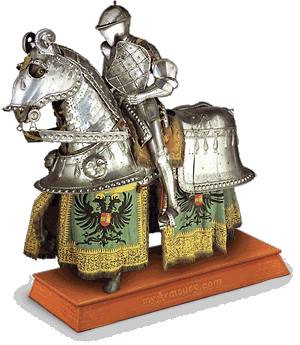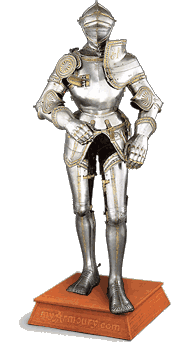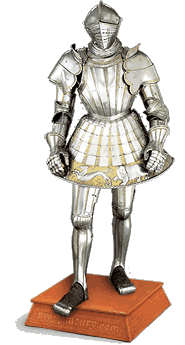
 |
|
|
Anatomy of Armour: Harnesses of Charles V
An article by Chad Arnow "Valladolid Garniture" Tournament Armour of Charles V, Holy Roman Emperor, King of Aragon, Castile, Naples, Sicily, and ruler of territories in Burgundy (1500-1558) Attributed to Kolman Helmschmid, Augsburg, circa 1520 Real Armerķa, Madrid As the grandson of Maximilian I, Charles V had access to the great armour workshop at Augsburg, headed by members of the Helmschmid family. Kolman Helmschid (1471-1532) seems to have been a favorite armourer of Charles V, and several of Charles' surviving harnesses are attributed to him, often despite a lack of armourer's marks to support the attribution. This harness for man and horse, designed for the tilt, was supposedly made for Charles in 1518 for his first trip to his kingdom in Spain.  As it is currently displayed in Madrid's Real Armerķa, the harness and bard is in part composite (comprised of pieces of multiple armours). The upper portion consists of a "frog-mouth" styled great helm, cuirass with tassets, arm and shoulder defenses shaped for the tournament, a besagew to cover the right armpit, a reinforcement for the left elbow, and two gauntlets. The right gauntlet is bifurcated (the index and middle fingers are protected by the same lames, separate from the lames that protect the ring and small fingers). The left gauntlet, of mitten form, extends from hand to elbow. This type of heavy gauntlet is often referred to as a manifer, which translates quite literally to "hand of iron."
As it is currently displayed in Madrid's Real Armerķa, the harness and bard is in part composite (comprised of pieces of multiple armours). The upper portion consists of a "frog-mouth" styled great helm, cuirass with tassets, arm and shoulder defenses shaped for the tournament, a besagew to cover the right armpit, a reinforcement for the left elbow, and two gauntlets. The right gauntlet is bifurcated (the index and middle fingers are protected by the same lames, separate from the lames that protect the ring and small fingers). The left gauntlet, of mitten form, extends from hand to elbow. This type of heavy gauntlet is often referred to as a manifer, which translates quite literally to "hand of iron."The legs are protected by cuisses, poleyns, demi-greaves, and mail shoes whose toes are protected by steel caps. The ribbed targe (shield), cuisses, and poleyns were not originally from this harness. Much of the armour is decorated with etched bands: the outer bands decorated with various foliate designs surrounding a plain inner band. The helm, gauntlets, vambraces, and backplate are decorated with a more elaborate version of one of these etched bands. The collar and emblem of the knightly Order of the Golden Fleece is etched into the top of the breastplate. The heavy helm (19 pounds, 13 ounces) is plain on its front where it might receive lance strikes, but is richly decorated on its back side, featuring the heads of two fire-breathing monsters. The greaves, which cover only the shin and sides of the leg, are bordered with leaves; the sides of the greaves are shaped to follow the outline of the foliage.
The peytral, which protects the chest, features two embossed lions, both of which are removable. The protection for the horse's rear, the crupper, is etched with Biblical scenes of combat, depicting David and Goliath and Samson versus the Philistines. The tail piece is shaped like a ram's head. Between the peytral and crupper on either side is a flanchard designed to protect the horse's flanks. It is completed by armoured reins and a saddle. The plates on the bard are decorated with bands of etching, embossing, and raised roping. The larger pieces also are decorated with an oak leaf pattern. The bard, minus its saddle, weighs around 97 pounds. "KD Garniture" Harness of Charles V, Holy Roman Emperor, King of Aragon, Castile, Naples, Sicily, and ruler of territories in Burgundy (1500-1558) Attributed to Kolman Helmschmid, Augsburg, circa 1525 Real Armerķa, Madrid  This harness for field or tournament is one of the better-known and more elegant examples of the 16th century armourer's craft. Built as a complete harness with pieces of exchange (extra pieces that could replace or be added to the harness for various styles of combat), it is most often seen as it is configured here.
This harness for field or tournament is one of the better-known and more elegant examples of the 16th century armourer's craft. Built as a complete harness with pieces of exchange (extra pieces that could replace or be added to the harness for various styles of combat), it is most often seen as it is configured here.It is often known by one of two names: the armour de bordes adiamantados (armour with diamond-studded borders) or as the "KD" Garniture for the letters on the raised haute-piece of the left pauldron (said to signify Karolus Divus—Divine Charles—an imperial title).
Many of its surfaces are fairly plain, but border sections are highly decorated. The decoration on the larger plates is usually in the form of five bordering bands. The outer two bands are roped in opposite directions. Immediately inside those bands are two bands, etched and gilt. The central band features raised pyramidal shapes whose sides are etched. Etching, gilding and diamond shapes abound all over the harness, though Helmschmid shows some restraint, breaking this up with the large expanses of unadorned steel. Tonlet Harness of Charles V, Holy Roman Emperor, King of Aragon, Castile, Naples, Sicily, and ruler of territories in Burgundy (1500-1558) Attributed to Kolman Helmschmid, Augsburg, circa 1525-30 Real Armerķa, Madrid  This harness is part of a larger garniture (with exchange pieces) in Madrid's royal armoury. Named for its tonlet, a skirt that protects the wearer, it was used exclusively for unmounted combat in tournaments. It consists of a close helmet, gorget, curiass, symmetrical pauldrons (another indication it was not for the joust), vambraces, bifurcated gauntlets, a full set of articulated breeches (lacking its codpiece), tonlet, cuisses, poleyns, greaves, and steel-capped mail shoes. Both the vambraces and the cuisses are articulated so that there are no gaps at the elbow or knee joints.
This harness is part of a larger garniture (with exchange pieces) in Madrid's royal armoury. Named for its tonlet, a skirt that protects the wearer, it was used exclusively for unmounted combat in tournaments. It consists of a close helmet, gorget, curiass, symmetrical pauldrons (another indication it was not for the joust), vambraces, bifurcated gauntlets, a full set of articulated breeches (lacking its codpiece), tonlet, cuisses, poleyns, greaves, and steel-capped mail shoes. Both the vambraces and the cuisses are articulated so that there are no gaps at the elbow or knee joints.Also known as the Tonlete de cacerrai (hunt tonlet), the harness's tonlet features a wide band at its base that depicts animals on the hunt: a bear, stag, and boar are all pursued by hunting dogs. Although now plain steel, these figures were once gilt and rendered to show fur and other fine details. The background on which they rest is etched and gilt, and the entire band is detachable.
Like Henry VIII's tonlet harness in the Tower of London, Charles's tonlet harness is a model of engineering. Fully enclosing the body, each of these examples protected the wearer from harm without limiting movement so much that competition would be difficult. Charles V obviously enjoyed foot combat, as this harness is one of three surviving tonlet harnesses attributed to him. One, known as the "Oakleaf tonlet" is in Madrid's Real Armerķa. The other, commissioned for him during his childhood by his grandfather Maximilian I, rests in Vienna. About the Author Chad Arnow is a classical musician from the greater Cincinnati area and has had an interest in military history for many years. Though his collecting tends to focus on European weapons and armour of the High Middle Ages, he enjoys swords, knives and armour from many eras. Acknowledgements Photographs copyrighted by Real Armerķa, Madrid |
|